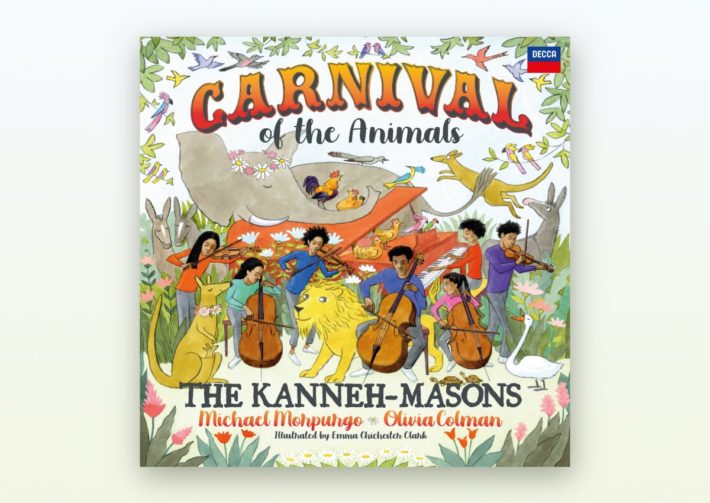In an eagerly awaited release from Decca, the Kanneh-Mason siblings take-on the ever-popular ‘Carnival of the Animals’ by Saint-Saëns and a selection of miscellaneous pieces, which are ideal for younger listeners. Preceding each of the movements, the author Michael Morpurgo — a name familiar to many avid youthful readers, has written verses setting each animal in an interesting context. The poems are read by the author and actress Olivia Colman, who provides some complementary and welcomed contrast.
The album is very much designed to be listened to either in its entirety or in two halves — one being the ‘Carnival of the Animals. Morpurgo opens with a gentle introduction, setting the work in context, which will help adults with limited knowledge of classical music and children coming to this for the first time.
The Kanneh-Masons are especially known to British audiences as a talented family of seven young musical siblings. The most famous of them — Sheku, was projected to fame after winning the prestigious BBC Young Musician of the Year in 2016 and performing at the Royal Wedding of Prince Harry and Meghan Markle. He has subsequently released two albums of his own before this collaboration with his brother and sisters (see this writer’s Elgar review here). Pianist Isata Kanneh-Mason released an album on the same label of works by Clara Schumann, reviewed here.
Related Classical Music Reviews
- Review: Elgar – Cello Concerto – Sheku Kanneh-Mason, Rattle
- Review: “Romance” – Isata Kanneh-Mason Plays Clara Schumann
- Review: “The Mythos Suite” – Debbie Wiseman, Stephen Fry
Scored for a small ensemble including two pianos, Carnival of the Animals certainly suites to the family ensemble. But Decca employed additional, high caliber musicians to work with the Kanneh-Mason family and enrich the interpretation: Adam Walker (flute), Mark Simpson (clarinet) and Adrian Spillett (percussion).
The performances are sufficiently characterful, from the roar of the lion to the flapping in the ‘Aviary’. The raspiness of the lion is aided by some raw double bass playing. Bassist Toby Hughes varies his colors and changes the tone distinctively in ‘The Elephant’, again finding the humor in the phrasing. Simpson’s clarinet playing is unique – in ‘Hens and Roosters’ his slides are distinctive, while in ‘The Cuckoo’ the different phrasing and dynamics bring a virtual woodland to the performance. Walker too is fine throughout.
The pianists that share the duo piano roles – Istata, Konya and Jeneba Kanneh-Mason, are formidable and aptly pitched in ‘Wild Donkeys’, their tempestuous scales are sufficiently tamed, allowing their technical dexterity and unity to shine. Unfortunately, their bright tones are of one color, lacking the warmth for ‘Tortoises’ and overly brittle in ‘The Elephant’. They do find the juvenile playfulness in ‘Kangaroos’ and ‘Pianists’, however.
Tempi choices are on the fast side, which doesn’t always serve the musical argument. Following the instrumentation in Saint-Saëns’ score, ‘Aquarium’ features a glass harmonica, here played by Alasdair Malloy, who features on Neeme Järvi’s recording. The slightly less convincing tempo of the new recording mutes the richness of the marine hues. ‘Fossils’ is occasionally overly articulated in the ritornellos, but the clarinet, viola and xylophone playing fully compensate. ‘The Swan’, the most famous movement of the piece (played by Sheku) is slightly hurried, and so the gracefulness of the movement is somewhat diminished.
Those familiar with the ‘Carnival of the Animals’ may find that Morpurgo’s poems punctuate just a little too much, interrupting the flow and occasionally produce too much of a hiatus. The concluding sequence has a seasonal Christmas theme, including ‘Dance of the Sugar Plum Fairy’ and ‘Flight of the Bumblebee’, again with a narrative by Morpurgo.
Overall, the performances have a youthful naivety, but lack the refinement of the Bergen Philharmonic with Louis Lortie and Helene Mercier on Chandos, the range of pianistic color of Martha Argerich and Antonio Pappano, or the chemistry of Katia and Marielle Labéque. This album is ideally pitched at the younger market and reservations aside, would be a suitable introduction to classical music for slightly older children, to which budding musicians could relate.












